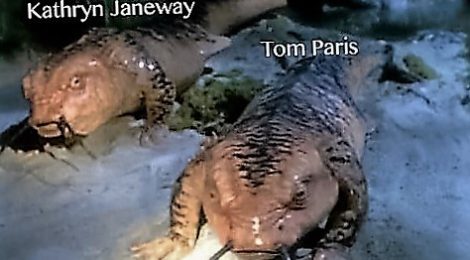
Devonian Mass Extinction Version 2.0
It is said history repeats itself, we had better hope not!
360 million years ago it was the Devonian Age, aka ‘the greenhouse age’ and the ‘age of fish’ suffered a great dying
It was the time that plants evolved and grew to cover the land in the first global greening that caused the oceans to suffer a terrible drought of dust – as a result almost all large ocean life became extinct.
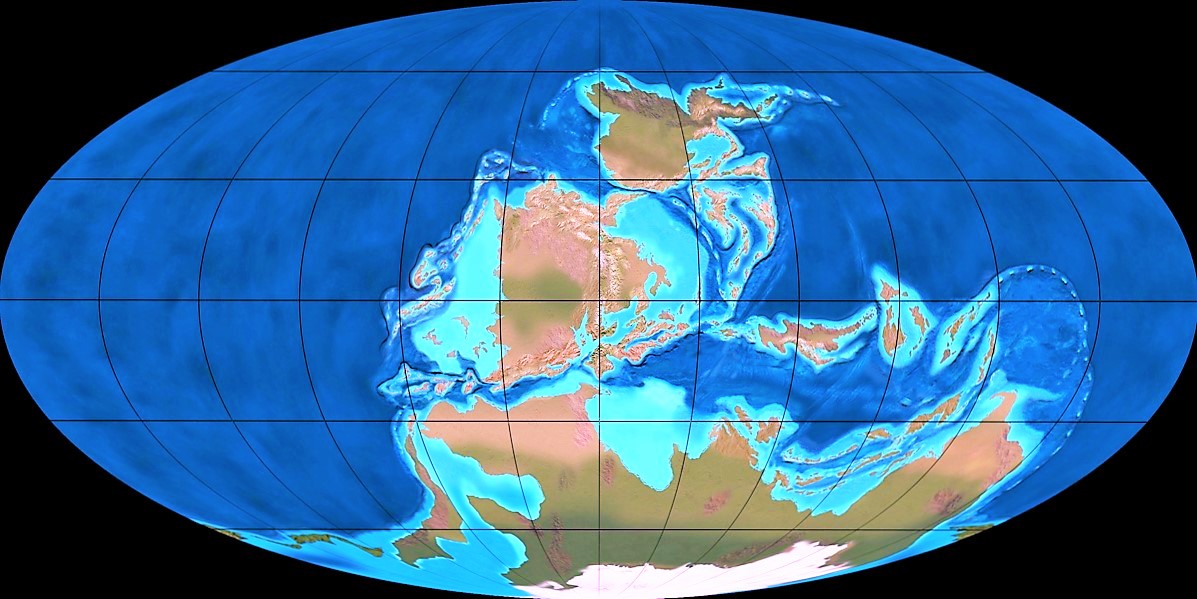
Devonian Earth was 80+% oceans, sea level was 600 ft above present day and much of continental uplift had yet to occur – click to enlarge
During the 60 million years of the Devonian Age this planet was covered with even more ocean than it is today. Sea level was 600 feet higher than today. Perhaps as little as half as much land existed (14%) here of Earth compared to todays 28%.
During the Devonian that the land was mostly a single super-continent, Gondwana, that had not yet begun to drift apart to make the familiar continents we see today. The Devonian was also the time when plant life on land began to rapidly diversify from its primitive rootless early lichens and moss into vast forests of the latter Devonian ages, the beginning of trees. The end of the Devonian age is marked by one of the greatest mass extinction in our planet’s history — 87+% of all animal life was lost.
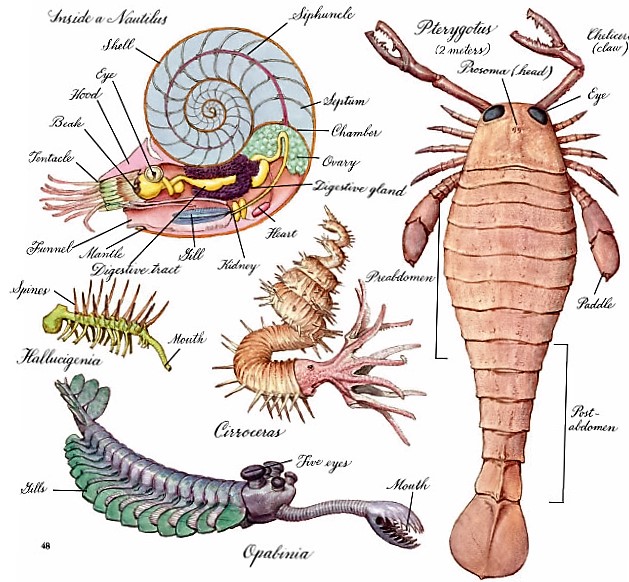
Devonian creatures were weird and wonderful, one the ancient Ammonite survives to this day as our Chambered Nautilus – click to enlarge
That Devonian extinction event was one of the worst mass extinctions in Earth’s history. Clearly, something dreadful must have happened, but what? There is no perfect smoking gun preserved, no sign of anything dramatic like giant craters or evidence of vast lave flows. Experts agree something small happened which changed the ocean ecology from an oasis of life to a sea of death.
This was a time long before even the dinosaurs walked the Earth, they would not evolve for another 150 million years, we ape-men would not come along for another 150 million years after the dinos.
For this blue planet it was the reign of the oceans and they were overwhelmingly filled with life, it was the reign of fish. It should not be surprising to know that as the oxygen of the oceans slowly declined that stimulus led to air gulping fish who evolved the ability to take to the land. The words ‘all we are is dust in the wind’ seems especially prophetic.
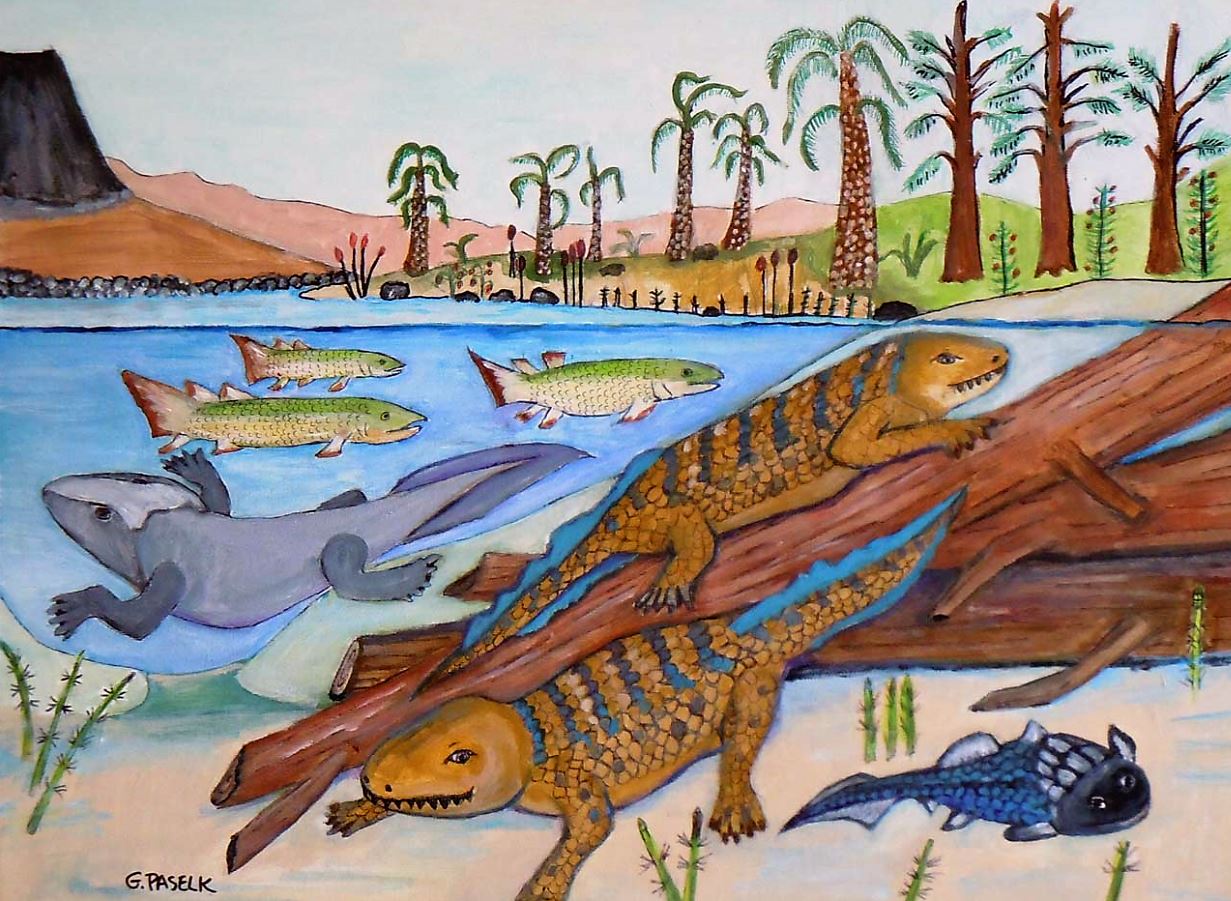
“It’s teeming with placoderm fish and they’re exquisitely preserved, in three dimensions,” says Michael Coates, an evolutionary biologist at the University of Chicago in Illinois. “They’re beautiful and weird.”
Were Devonian Ocean Pastures Killed Off By Growing Terrestrial Plant Biodiversity — More Plants Growing Meant Less Dust Blowing
The Devonian period saw the rise of “vascular” land plants, a group that became everything from trees to ferns to flowering plants. These new Devonian plants moved in on the more primitive mosses, lichens, and liverworts that were there before the Devonian began.
The vascular plants were wildly successful and rapidly covered the warmer wet earth of the age. It was 6 degrees C warmer than today, there would have been virtually no ice at all. It was the first ‘greenhouse age.’ The rapidly diversifying and growing plants transformed the rocky sandy world into a world of soil, a precious material they held onto protectively with their new root systems. Life was good on the earth with the onset of enormous plant biodiversity.
But the transformation of the earth was not so great for oceans and the dramatic change of terrestrial ecology meant an even more dramatic change for the long-standing ocean ecosystem.
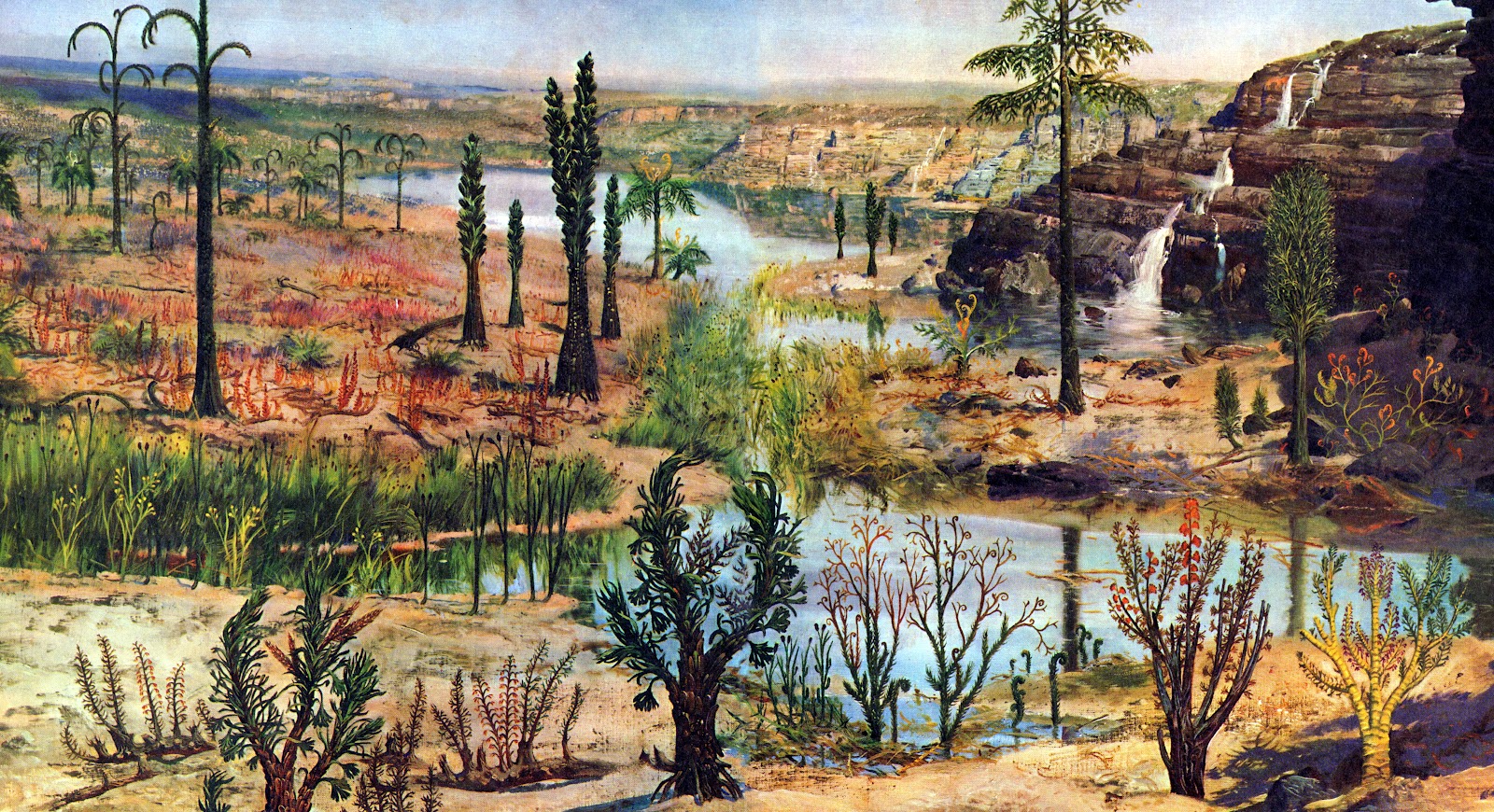
Middle Devonian Landscape by Zdenek Burian
The lush Devonian plant life that grew to cover the land eventually prevented minerals from blowing in the vigorous winds of the more energetic warmer Devonian — also known as the “Greenhouse Age”. The loss of vital terrestrial minerals was certain doom for Devonian ocean pastures, especially those that were farthest from land, and that was most but not all of the Devonian great sea called the Panthalassa.
Confirming the vital role of terrestrial minerals to ocean life is a recent paper showing the coincident drop of vital minerals to 1%-10% of the norm associated with the Devonian and other mass extinction events. Surely some near shore ocean refugia remained as evidenced by the fact that while most ocean life went extinct NOT all did so. The geologic record shows deep water regions most removed from terrestrial minerals were hardest hit.
Dust in the wind is the Yin & Yang counterpart to rain for the two biospheres of this blue planet. When the rain doesn’t fall on land the plants that grow in mineral soil cannot survive the drought. When the dust doesn’t fall on the oceans the ocean plants that grow in water cannot survive the drought of dust.
Levels of ocean pasture collapse may well have varied from place to place on the Devonian Earth. That seems likely as this was also a time where little change was going on with the continents, if you get my drift. There was still primarily the one super-continent Gondwana with just a few small bits of yet to be uplifted with mountain building still long from happening.
“There weren’t any mountain-building events in Western Australia,” says Kelly Hillburn of the University of Washington. “You’re still putting in some continental run-off, but nowhere near the amount you’re putting in say in Europe or North America today.”
The Devonian extinction didn’t happen all at once and washed over the planet in two great waves, one 359 million years ago and one 372 million years ago. The one two punch was especially deadly making the Devonian extinction perhaps the worst in Earth’s history.
Life appears to be its own worst enemy
Peter Ward of the Univ. of Washington has penned a theory about life on Earth he calls the “Medea Hypothesis”, which simply states that life is ultimately self-destructive. The land plants are a classic example, says Ward.
“To begin with these trees are winning the whole battle, it’s great for them. But then there is the unforeseen consequence. The plants’ deep roots set off a series of chain reactions. All of a sudden they’ve screwed the entire biosphere.”
Two other mass extinctions seem to have involved nutrients that control the productivity of ocean pasture phyto-plankton. The “Great Dying” 250 million years ago and the End-Triassic mass extinction 201 million years ago have been said to have resulted when sudden dusty times caused the oceans to go into a bloom and bust scenario.
More recently California oceanographer John Martin has shown that ice-ages were perfectly correlated with dust and plankton blooming. Martin explained that when our planet was only just barely kept warm by the thinnest coverlet of ‘greenhouse gases’, pre-fossil fuel age, an increase in ocean plant life could pull enough CO2 out if the air to throw the planet into an ice age. NASA is a great fan of the late great John Martin and have created a special website about him the call “On The Shoulders of Giants.”
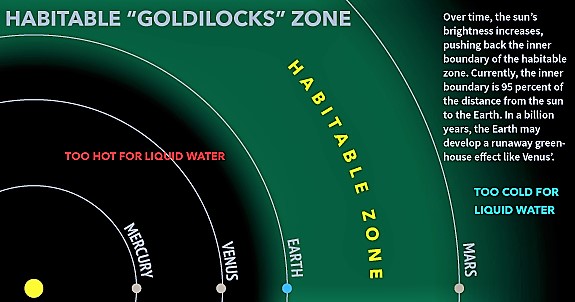
Our Earth is just barely within the habitable ‘Goldilocks Zone,’ if not for the fact that ocean plankton evolved the ability to cool our planet we’d all be cooked. – click to enlarge
The ice ages would not last so long however as our Earth is just barely within the Goldilocks Zone in our Solar System. It is the oceans and their principal life, the photosynthetic plankton that keep us cool through the most powerful force of Nature — Plankton Cooling.
Ocean plants are the principal source of cloud forming aerosols on this blue planet today, even more so during the Devonian age. It is the clouds they make that provide them (and us) with our livable, not too hot, not too cold, but our just right livable environment.
Do We Learn From History
Today Ocean phyto-plankton is being decimated as a result of a second ‘global greening’ and for the past 50 years the rate of loss has been 1% per year. That’s the same amount of ocean plant life lost as if we were to eradicate 10 Amazon Rainforests in the same 50 years. As a result recent scientific reports suggest that the oceans will stop being a net producer of oxygen by the end of this century. Already it is known that species have been going extinct 100 times faster than what has been deemed the natural rate. Many are willing to say we are on the road to the sixth great mass extinction in Earth’s history. It’s been 65 million years since the last one that wiped out the dinosaurs.
Here’s a scary bit, of all the mass extinctions known to science, the Late Devonian extinction is closest to what’s going with our world today. There is widespread ‘global greening’ taking place on land and simultaneously there is a cataclysmic collapse of ocean plant life. The Devonian extinction reveals that when this happened before, the world was a stage for massive change which led to entirely new forms of terrestrial and ocean life. Only the plankton remained the same.
Do or Do Not That Is The Question
At this point in Earth’s history something different regarding global mass extinctions is clear. We humans have imposed sufficient technology to drive the planet into another extinction event AND we have evolved enough intelligence to have the power to prevent that cataclysm. The choice is simple DO WE act to restore and sustain the ocean pasture plant life, the phyto-planktoon, or DO WE NOT and rest our fate and that of the rest of life on this beautiful small blue planet to try another roll of the evolutionary dice.
To learn what happens if we do the right thing we can do so at the cost of mere millions of dollars each year to become caring stewards of our ocean pastures and sustain them and ourselves for millennia seeing the results of our labor revealed within 5-10 years.
The alternative is DO NOT and at some time a few hundred million years from now perhaps some new geologic historian will report on the result. Or even produce another episode of Star Trek to tell the story.
Star-Trek Goes Devonian
Bring back the dust and the fish, better, faster, cheaper! Join me.









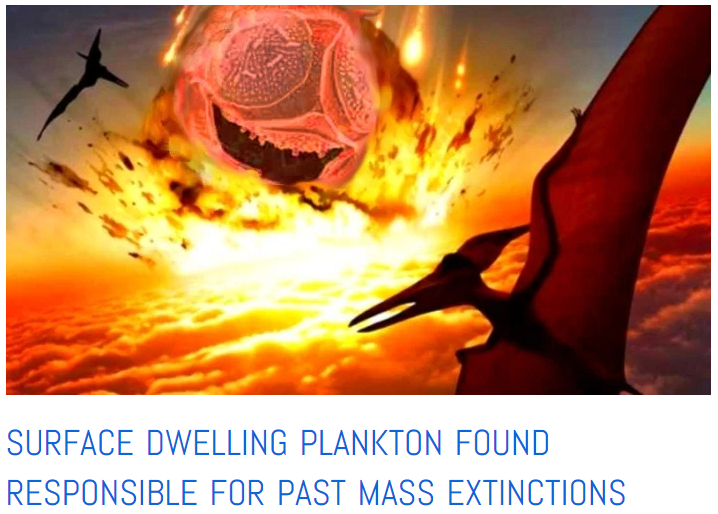
Russ, do you know of any plans or campaigns to do another test similar to the one you did several years ago? This seems promising and it would be great to get behind another project to prove that it can work.